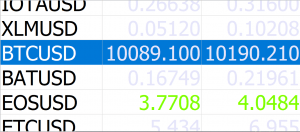Contents:
She spends her days working with hundreds of employees from non-profit and higher education organizations on their personal financial plans. The most common setting or look back period for the RVI oscillator is 10 periods, but it is common to use 7, 9, 14 periods for the RVI oscillator as well. Divergence based trading can be also be one of the uses of the RVI oscillator. This template is very clear, so the trading decisions are simple and immediate without confusion that can result from the use of many indicators . Forex day trading is the most popular method of retail forex… Oscillators are an important part of technical analysis.
Implied Volatility vs. Historical Volatility: What’s the Difference? – Investopedia
Implied Volatility vs. Historical Volatility: What’s the Difference?.
Posted: Sat, 25 Mar 2017 07:53:07 GMT [source]
Still, you can tweak this period to suit your trading strategy. The process of calculating the relative vigor index is relatively complex compared to other indicators. This should not scare you because you are not requited to do the calculations yourself. Instead, it is recommended that you know the meaning of the indicator and how to use it when trading. These indicators are divided into leading and lagging indicators. Lagging indicators are the likes of moving averages and the Parabolic SAR while leading indicators are the likes of the Relative Strength Index and MACD.
At such readings, traders watch out for a cross of the signal line. As an oscillator, RVI swings above and below a centreline. The RVI centreline is the 0 reading, which means that the indicator delivers both positive and negative readings.
Relative Vigor Index (RVI): Definition, Formula, Uses in Trading
Hours of practice are also recommended to refine your step-by-step trading plan with the Relative Vigor Index. The RVI is one of several oscillators offered on the MetaTrader4 platform, but there are many proprietary systems that do not include it in their indicator arsenal. It differs from most other oscillators in that there are no upper and lower regions defined within a 100% scaling. On the contrary, the RVI oscillates around a centreline zero base value. Combining the RVI Indicator with other indicators makes for a powerful combination.
This article discusses one of the most sought after technical analysis… The Relative Volatility Index is based on the Relative Strength Index . Whereas the RSI uses the average price change, the RVI uses a 9 period standard deviation of the price. You can open a trading account with any of the MT4 Forex brokers to freely use the presented here indicator for MetaTrader 4. If you want to use an MT5 version of the indicator presented here, you would need to open an account with a broker that offers MetaTrader 5.
The https://forexbitcoin.info/r takes profit on half of the existing buy position. The RVI indicator is calculated in a similar fashion to the stochastics oscillator but it compares the close relative to the open rather than comparing the close relative to the low. CFDs are complex instruments and come with a high risk of losing money rapidly due to leverage. Between 74-89% of retail investor accounts lose money when trading CFDs. You should consider whether you understand how CFDs work and whether you can afford to take the high risk of losing your money. The RVI indicator is based on an idea that the price action has a tendency to close higher compared to the opening prices in an uptrend, and have lower closing prices than opening in a downtrend.
Sell Rules
There are straight and hidden divergences in the market. A straight bullish divergence will occur when the asset price is making lower lows, but the RVI makes higher lows. This will be a signal that the price lacks ‘vigour’ and traders will look to place buy orders in anticipation of an upward price reversal. Similarly, a bearish divergence will occur when the price is making higher highs, but the RVI makes lower highs. When a bearish divergence occurs, traders will look for opportunities to place sell orders in anticipation of a downward price reversal.
Oscillators were some of the first technical indicators created to signify overbought and oversold conditions. Formulas may differ by design, but each indicator is trying to gauge the strength and direction of a trend by observing small divergences in how investors are reacting to current price behaviour. The value of «Vigor» in the RVI indicator is calculated based on the difference between the values of the opening level and closing level. The indicator is calculated as a value equal to the actual price change for a period, normalized to the maximum price range of this period, for example, minute, day, or hour. The Relative Vigor Index indicator is classified as an oscillator since its values fluctuate between computed positive and negative values.
When using the RVI in crypto, the index assumes that if Bitcoin or another altcoin is in a bull run, prices will likely close higher the next day in an uptrend or close lower in a downtrend. Once the trader has a long position established in an overall uptrend, he or she monitors the RVI for bearish divergence from price. Price makes a new high, but the RVI does not make a corresponding new high.
A Must-ReadeBook for Traders
When you see the green RVI line cross above the red signal line, and this takes place below the horizontal zero line, that can signal the reversal of a downtrend and the start of an uptrend. You also can choose colors for the RVI and signal lines. By default, the signal line is red and the RVI line is green. You can adjust the minimum and maximum for the Relative Vigor Index scale in the Scale tab if you want.

After a few periods, the price decreases ~$1.16 leaving us with a nice trading profit. The relative vigor index is a technical indicator, which anticipates changes in market trends. Many day traders consider the RVI a “first cousin” of the Stochastic Oscillator due to the similarities in their formulas . Steps “2” and “3” represent prudent risk and money management principles that should be employed. This simple trading system would have yielded one profitable trade for 60 pips, but do remember that the past is no guarantee for the future. However, consistency is your objective, and hopefully, over time, Relative Vigor Index technical analysis will provide you with an edge.
Types of RVI Trade Signals
After applying the RVI, you need to look closely at when the two lines intersect. Technical analysis focuses on market action — specifically, volume and price. Technical analysis is only one approach to analyzing stocks. When considering which stocks to buy or sell, you should use the approach that you’re most comfortable with. The Relative Vigor Index is an oscillator based on the concept that prices tend to close higher than they open in up trends and close lower than they open in down trends. Basically, it is an oscillator that is in phase with the cycle of the underlying’s price.

However, the indicator has some limitations such as sending the wrong signals and being relatively difficult to calculate. Another relatively simple way of using the RVI indicator is to trade divergences. This refers to a situation where the price of an asset is rising while that of the indicator is falling. By the way, the first step is to look at a chart visually and seeing how it is trending. You should use the RVI when the market is trending, this will help you get the real signal.
The Relative Vigor Index, explained within the context of other oscillators, is a very useful tool to have in your technical analysis bag of tricks. Signals and alerts are more about how the index diverges from price behaviour, although, as with the RSI and Stochastics, extreme highs and lows do represent overbought and oversold territories. The RVI is classified as a leading indicator in that it attempts to portend the future, but it is also teamed up with a lagging moving average to assist with its interpretations. The Relative Vigor Index indicator is composed of two fluctuating curves – the “Green” line, which is the smoother RVI values, and the “Red” signal line. The weakness in the indicator is timing and that it often gives counter-intuitive values that confuse rather than assist traders. Using an additional indicator reduces the propensity for false signals.
If the market is flat, look for the RVI to exit the overbought or oversold areas for a signal to sell/buy. Note that the indicator doesn’t offer exact levels for overbought and oversold areas, so traders need to figure this out themselves. It addition, it’s necessary to remember that oscillators can remain at extreme levels over a prolonged period of time. The Relative Vigor Index, in contradistinction to classical oscillators, does not have overbought and oversold zones but provides trading signals to making trends by crossing RVI and signal line. If I line crosses the signal top-down, a purchase is made with a stop order placed behind the last extremum at the opening of the next candle.
In this case, the two divergent periods, where the RVI is declining while prices are still increasing, might be the opposite of what a trader might expect. The Green circles have been added to suggest when the divergent period ends and when the crossover connotes a time for action. A Relative Vigor Index strategy built around the unique characteristics of the RVI can be very simple and straightforward. This particular indicator works best in a trending market. In the previous overview example, the RVI faithfully predicted the path toward a ranging period, but it is not the best tool for forecasting a breakout from range-bound activity.
The inherent danger of using hantec markets broker overviews is that they can deliver false signals in the middle of strong trends, but this can sometimes be mitigated by combining them with other indicators. Some of the most common oscillators, other than RVI, include Stochastics, MACD, RSI and CCI . The trader continues taking half profits, then resumes a full long position while the overall uptrend remains intact, as determined by the price remaining above the 100-period moving average .
- You have likely read some general articles on the RSI in your trading career, or have at least heard about…
- If price has higher highs, but the RVI lines have lower highs, that is bearish divergence.
- It’s a good idea to use the RVI indicator in conjunction with other forms of technical analysis in order to find the highest probability outcomes.
- Adam received his master’s in economics from The New School for Social Research and his Ph.D. from the University of Wisconsin-Madison in sociology.
- For our exit point, we wait for a divergence to present itself between the rising price trend and the RVI data points.
The RVI measures trend strength by comparing the open-close and high-low ranges for the current and three most recent periods. As a zero-centered oscillator, the RVI oscillates above and below zero to signal the strength of the trend. The vast majority of retail investor accounts lose money when trading CFDs.
